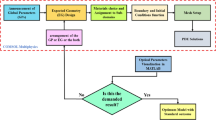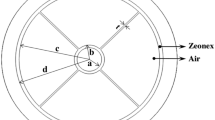Abstract
Now a day’s breast cancer is a concern in modern science and medicine, consequently establishing an effective and precise breast cancer cell detection approach becomes extremely important. Photonic crystal fiber-based sensor makes this approach smoother and more innovative. A unique THz sensor based on hollow core photonic crystal fiber facilitating chemical analytes detection within terahertz frequency range has been reported in the present work. Efficiency of the presented sensor has been investigated numerically applying simulation technology based on the finite element technique. A photonic crystal fiber biosensor is designed to detect cancerous cells, all the proposed combinations have been implemented by using finite element approach, and the performance of the proposed model has been evaluated by MATLAB software. The reported sensor could be operated in the frequency range 1.0–2.0 THz. Simulation results are found to be good enough, with highly birefringence (0.0020), lower confinement loss (17.33 × 10–9 dB/cm), lower effective area (3.04 × 10–8 µm2), a higher relative sensitivity (65.53%) along x-axis, relative sensitivity (53.63%) along y-axis, effective refractive index (1.376), nonlinear coefficient (6.38 × 1016) and dispersion (0.1588 ± 0.0121). Furthermore, the proposed sensor's manufacturing capabilities remain assured by its ease of implementation.











Similar content being viewed by others
Data availability
Data will be available made on request.
References
X.D. Wang, O.S. Wolfbeis, Fiber-optic chemical sensors and biosensors (2008–2012). Anal Chem 85, 487–508 (2013). https://doi.org/10.1021/ac303159b
F. Wu, P.A. Thomas, V.G. Kravets et al., Layered material platform for surface plasmon resonance biosensing. Sci Rep 9, 1–10 (2019). https://doi.org/10.1038/s41598-019-56105-7
J.D. Shephard, W.N. MacPherson, R.R.J. Maier et al., Single-mode mid-IR guidance in a hollow-core photonic crystal fiber. Opt Express 13, 7139 (2005). https://doi.org/10.1364/opex.13.007139
A. Ramola, A. Marwaha, S. Singh, Design and investigation of a dedicated PCF SPR biosensor for CANCER exposure employing external sensing. Appl. Phys. A Mater. Sci. Process. 127 (2021). https://doi.org/10.1007/s00339-021-04785-2
P.J. Roberts, F. Couny, H. Sabert et al., Ultimate low loss of hollow-core photonic crystal fibres. Opt Express 13, 236 (2005). https://doi.org/10.1364/opex.13.000236
A. Kumar Shakya, S. Singh, Design of novel Penta core PCF SPR RI sensor based on fusion of IMD and EMD techniques for analysis of water and transformer oil. Meas. J. Int. Meas. Confed. 188, 110513 (2022). https://doi.org/10.1016/j.measurement.2021.110513
S. Yadav, P. Lohia, D.K. Dwivedi, A Novel Approach for Identification of Cancer Cells Using a Photonic Crystal Fiber-Based Sensor in the Terahertz Regime. Plasmonics (2023). https://doi.org/10.1007/s11468-023-01887. https://doi.org/10.1007/s11468-023-01887-w
A. Upadhyay, S. Singh, Y.K. Prajapati, R. Tripathi, Numerical analysis of large negative dispersion and highly birefringent photonic crystal fiber. Optik (Stuttg) 218, 164997 (2020). https://doi.org/10.1016/j.ijleo.2020.164997
K.D. Miller, M. Fidler-Benaoudia, T.H. Keegan et al., Cancer statistics for adolescents and young adults, 2020. CA Cancer J Clin 70, 443–459 (2020). https://doi.org/10.3322/caac.21637
Y. Ryu, S. Moon, Y. Oh, et al., Effect of coupled graphene oxide on the sensitivity of surface plasmon resonance detection. Appl. Opt. 53, 1419 (2014). https://doi.org/10.1364/ao.53.001419
Y. Singh, M.K. Paswan, S.K. Raghuwanshi, Sensitivity enhancement of SPR sensor with the black phosphorus and graphene with bi-layer of gold for chemical sensing. Plasmonics 16, 1781–1790 (2021). https://doi.org/10.1007/s11468-020-01315-3
A.K. Shakya, S. Singh, State of the art alliance of refractive index sensing and spectroscopy techniques for household oils analysis. Plasmonics (2023). https://doi.org/10.1007/s11468-023-01940-8
C.S. Kumar, R. Anbazhagan, Investigation on chalcogenide and silica based photonic crystal fibers with circular and octagonal core. AEU Int J Electron Commun 72, 40–45 (2017). https://doi.org/10.1016/j.aeue.2016.11.018
P. Kumar, V. Kumar, J.S. Roy, Design of quad core photonic crystal fibers with flattened zero dispersion. AEU Int J Electron Commun 98, 265–272 (2019). https://doi.org/10.1016/j.aeue.2018.11.014
S. Yadav, S. Singh, P. Lohia et al., Delineation of profoundly birefringent nonlinear photonic crystal fiber in terahertz frequency regime. J. Opt. Commun. (2022). https://doi.org/10.1515/joc-2022-0143
S. Luke, S.K. Sudheer, V.P.M. Pillai, Modeling and analysis of a highly birefringent chalcogenide photonic crystal fiber. Optik (Stuttg) 126, 3529–3532 (2015). https://doi.org/10.1016/j.ijleo.2015.08.190
A.K. Shakya, S. Singh, Novel Merger of spectroscopy and refractive index sensing for modelling hyper sensitive hexa-slotted plasmonic sensor for transformer oil monitoring in near-infrared region. Opt Quantum Electron 55, 1–25 (2023). https://doi.org/10.1007/s11082-023-05016-z
Z.H. Tawfiq, M.A. Fakhri, S.A. Adnan, Photonic crystal fibres pcf for different sensors in review. IOP Conf. Ser. Mater. Sci. Eng. 454: (2018). https://doi.org/10.1088/1757-899X/454/1/012173
A.K. Shakya, S. Singh, Design of a novel refractive index BIOSENSOR for heavy metal detection from water samples based on fusion of spectroscopy and refractive index sensing. Optik (Stuttg) 270, 169892(2022). https://doi.org/10.1016/j.ijleo.2022.169892
H. Han, H. Park, M. Cho, J. Kim, Terahertz pulse propagation in a plastic photonic crystal fiber. Appl Phys Lett 80, 2634–2636 (2002). https://doi.org/10.1063/1.1468897
S. Singh, A.K. Sharma, P. Lohia et al., Design and modelling of high-performance surface plasmon resonance refractive index sensor using BaTiO3, MXene and nickel hybrid nanostructure. Plasmonics 17, 2049–2062(2022). https://doi.org/10.1007/s11468-022-01692-x
J. Anthony, R. Leonhardt, A. Argyros, M.C.J. Large, Characterization of a microstructured Zeonex terahertz fiber. J Opt Soc Am B 28, 1013 (2011). https://doi.org/10.1364/josab.28.001013
Y. Singh, S.K. Raghuwanshi, sensitivity enhancement of the surface plasmon resonance gas sensor with black phosphorus. IEEE Sensors Lett 3, 18–21 (2019). https://doi.org/10.1109/LSENS.2019.2954052
M.F.H. Arif, M.M. Hossain, N. Islam, S.M. Khaled, A nonlinear photonic crystal fiber for liquid sensing application with high birefringence and low confinement loss. Sens. Bio Sens. Res. 22, 100252 (2019). https://doi.org/10.1016/j.sbsr.2018.100252
M.J.B.M. Leon, M.A. Kabir, Design of a liquid sensing photonic crystal fiber with high sensitivity, bireferingence and low confinement loss. Sens. Bio Sens. Res. 28 100335(2020). https://doi.org/10.1016/j.sbsr.2020.100335
M.M. Hasan, S. Sen, M.J. Rana et al., Heptagonal photonic crystal fiber based chemical sensor in THz regime. In: 2019 Jt 8th Int Conf Informatics, Electron Vision, ICIEV 2019 3rd Int Conf Imaging, Vis Pattern Recognition, icIVPR 2019 with Int Conf Act Behav Comput ABC, pp. 40–44(2019). https://doi.org/10.1109/ICIEV.2019.8858555
I. Yakasai, P.E. Abas, S.F. Kaijage et al., Proposal for a quad-elliptical photonic crystal fiber for terahertz wave guidance and sensing chemical warfare liquids. Photonics 6 (2019). https://doi.org/10.3390/photonics6030078
S. Asaduzzaman, M.F.H. Arif, K. Ahmed, P. Dhar, Highly sensitive simple structure circular photonic crystal fiber based chemical sensor. In: 2015 IEEE Int WIE Conf Electr Comput Eng WIECON-ECE 2015 1, 151–154 (2016). https://doi.org/10.1109/WIECON-ECE.2015.7443884
M. De, T.K. Gangopadhyay, V.K. Singh, Prospects of photonic crystal fiber as physical sensor: an overview. Sensors (Switzerland) 19(2019). https://doi.org/10.3390/s19030464
V.S. Chaudhary, D. Kumar, B.P. Pandey, S. Kumar, advances in photonic crystal fiber-based sensor for detection of physical and biochemical parameters—a review. IEEE Sens J 23, 1012–1023 (2022). https://doi.org/10.1109/JSEN.2022.3222969
C. Kalyoncu, A. Yasli, H. Ademgil, Machine learning methods for estimating bent photonic crystal fiber based SPR sensor properties. Heliyon 8, e11582(2022). https://doi.org/10.1016/j.heliyon.2022.e11582
Y. Yi, Y. Ma, S. Wang et al., A new strain sensor based on depth-modulated long-period fiber grating. Infrared Phys. Technol. 111, 103520(2020). https://doi.org/10.1016/j.infrared.2020.103520
H. Liu, H. Li, Q. Wang et al., Temperature-compensated magnetic field sensor based on surface plasmon resonance and directional resonance coupling in a D-shaped photonic crystal fiber. Optik (Stuttg) 158, 1402–1409 (2018). https://doi.org/10.1016/j.ijleo.2018.01.033
V.S. Chaudhary, D. Kumar, R. Mishra, S. Sharma, Hybrid dual core photonic crystal fiber as hydrostatic pressure sensor. Optik (Stuttg) 210, 164497(2020). https://doi.org/10.1016/j.ijleo.2020.164497
L. Zhao, H. Han, Y. Lian et al., Theoretical analysis of all-solid D-type photonic crystal fiber based plasmonic sensor for refractive index and temperature sensing. Opt Fiber Technol 50, 165–171 (2019). https://doi.org/10.1016/j.yofte.2019.03.013
F. Zhang, S. Liu, Y. Wang et al., Highly sensitive torsion sensor based on directional coupling in twisted photonic crystal fiber. Appl. Phys. Exp. 11(2018), https://doi.org/10.7567/APEX.11.042501
T. Wang, Y. Mao, B. Liu et al., compact fiber optic sensor for temperature and transverse load measurement based on the parallel vernier effect. IEEE Photon. J 14, 1–8 (2022). https://doi.org/10.1109/JPHOT.2022.3206313
N. Ayyanar, G. Thavasi Raja, M. Sharma, D. Sriram Kumar, photonic crystal fiber-based refractive index sensor for early detection of cancer. IEEE Sens. J. 18, 7093–7099(2018). https://doi.org/10.1109/JSEN.2018.2854375
A.M. Maidi, P.E. Abas, P.I. Petra et al., Theoretical considerations of photonic crystal fiber with all uniform-sized air holes for liquid sensing. Photonics 8(2021). https://doi.org/10.3390/photonics8070249
Z. Liu, F. Sun, C. Wang, H. Tian, Side-coupled nanoscale photonic crystal structure with high-Q and high-stability for simultaneous refractive index and temperature sensing. J Mod Opt 66, 1339–1346 (2019). https://doi.org/10.1080/09500340.2019.1617444
S Sen, M Abdullah-Al-Shafi, AS Sikder, et al., Zeonex based decagonal photonic crystal fiber (D-PCF) in the terahertz (THz) band for chemical sensing applications. Sens Bio Sens Res 31:100393(2021). https://doi.org/10.1016/j.sbsr.2020.100393
M.S. Islam, J. Sultana, M. Faisal et al., A modified hexagonal photonic crystal fiber for terahertz applications. Opt Mater (Amst) 79, 336–339 (2018). https://doi.org/10.1016/j.optmat.2018.03.054
C. Wu, B.-O. Guan, C. Lu, H.-Y. Tam, Salinity sensor based on polyimide-coated photonic crystal fiber. Opt Express 19, 20003 (2011). https://doi.org/10.1364/oe.19.020003
B. Krishnamoorthi, B. Elizabeth Caroline, M. Michael, S. Thirumaran, A novel rhombic shaped photonic crystal bio-sensor for identifying disorders in the blood samples. Opt. Quant. Electron 55, 1–21(2023). https://doi.org/10.1007/s11082-023-04584-4
R. Saha, M.M. Hossain, M.E. Rahaman, H.S. Mondal, Design and analysis of high birefringence and nonlinearity with small confinement loss photonic crystal fiber. Front Optoelectron 12, 165–173 (2019). https://doi.org/10.1007/s12200-018-0837-6
M.A. Mollah, M. Yousufali, I.M. Ankan et al.,Twin core photonic crystal fiber refractive index sensor for early detection of blood cancer. Sens. Bio Sens. Res. 29, 100344 (2020). https://doi.org/10.1016/j.sbsr.2020.100344
X. Yang, C. Shi, D. Wheeler et al., High-sensitivity molecular sensing using hollow-core photonic crystal fiber and surface-enhanced Raman scattering. J Opt Soc Am A 27, 977 (2010). https://doi.org/10.1364/josaa.27.000977
A.M.R. Pinto, M. Lopez-Amo, Photonic crystal fibers for sensing applications. J Sensors (2012). https://doi.org/10.1155/2012/598178
A. Ghazanfari, W. Li, M.C. Leu, G.E. Hilmas, A novel freeform extrusion fabrication process for producing solid ceramic components with uniform layered radiation drying. Addit Manuf 15, 102–112 (2017). https://doi.org/10.1016/j.addma.2017.04.001
H. Ebendorff-Heidepriem, J. Schuppich, A. Dowler et al., 3D-printed extrusion dies: a versatile approach to optical material processing. Opt. Mater. Exp. 4 1494 (2014). https://doi.org/10.1364/ome.4.001494
R.M. Almeida, S. Portal, Photonic band gap structures by sol-gel processing. Curr Opin Solid State Mater Sci 7, 151–157 (2003). https://doi.org/10.1016/S1359-0286(03)00045-7
A.M. Cubillas, S. Unterkofler, T.G. Euser et al., Photonic crystal fibres for chemical sensing and photochemistry. Chem Soc Rev 42, 8629–8648 (2013). https://doi.org/10.1039/c3cs60128e
V. Kaur, S. Singh, Extremely sensitive multiple sensing ring PCF sensor for lower indexed chemical detection. Sens Bio Sensing Res 15, 12–16 (2017). https://doi.org/10.1016/j.sbsr.2017.05.001
T. Yang, C. Ding, R.W. Ziolkowski, Y.J. Guo, A terahertz (THz) single-polarization-single-mode (SPSM) photonic crystal fiber (PCF). Materials (Basel) 12(2019). https://doi.org/10.3390/ma12152442
R.H. Jibon, A.A.M. Bulbul, M.E. Rahaman, Numerical investigation of the optical properties for multiple PCF structures in the THz regime. Sens. Bio Sens. Res. 32, 100405 (2021). https://doi.org/10.1016/j.sbsr.2021.100405
M.S. Islam, J. Sultana, K. Ahmed et al., A novel approach for spectroscopic chemical identification using photonic crystal fiber in the terahertz regime. IEEE Sens J 18, 575–582 (2018). https://doi.org/10.1109/JSEN.2017.2775642
M.B. Hossain, E. Podder, A.A.M. Bulbul, H.S. Mondal, Bane chemicals detection through photonic crystal fiber in THz regime. Opt. Fiber Technol. 54, 102102 (2020). https://doi.org/10.1016/j.yofte.2019.102102
K. Ahmed, F. Ahmed, S. Roy et al., Refractive index-based blood components sensing in terahertz spectrum. IEEE Sens J 19, 3368–3375 (2019). https://doi.org/10.1109/JSEN.2019.2895166
M.S. Islam, S. Rana, M.R. Islam et al., Porous core photonic crystal fibre for ultra-low material loss in THz regime. IET Commun 10, 2179–2183 (2016). https://doi.org/10.1049/iet-com.2016.0227
B. Fischer, M. Hoffmann, H. Helm et al., Chemical recognition in terahertz time-domain spectroscopy and imaging. Semicond. Sci. Technol. 20(2005). https://doi.org/10.1088/0268-1242/20/7/015
Acknowledgements
The first author (Sapana Yadav) expresses gratitude to Madan Mohan Malaviya University of Technology Gorakhpur, India, for financial assistance. Dr. Sachin Singh, Institute of Advanced Materials, IAAM, Sweden and Dr. Yadvendra Singh, Boise University, USA have also expressed gratitude for their precious cooperation and assistance.
Funding
Not applicable.
Author information
Authors and Affiliations
Corresponding author
Ethics declarations
Conflict of interest
The corresponding author affirms there is no conflict of interest on representative of all authors.
Additional information
Publisher's Note
Springer Nature remains neutral with regard to jurisdictional claims in published maps and institutional affiliations.
Rights and permissions
Springer Nature or its licensor (e.g. a society or other partner) holds exclusive rights to this article under a publishing agreement with the author(s) or other rightsholder(s); author self-archiving of the accepted manuscript version of this article is solely governed by the terms of such publishing agreement and applicable law.
About this article
Cite this article
Yadav, S., Lohia, P. & Dwivedi, D.K. Quantitative analysis of highly efficient PCF-based sensor for early detection of breast cancer cells in THz regime. J Opt 53, 2642–2655 (2024). https://doi.org/10.1007/s12596-023-01404-6
Received:
Accepted:
Published:
Issue Date:
DOI: https://doi.org/10.1007/s12596-023-01404-6




